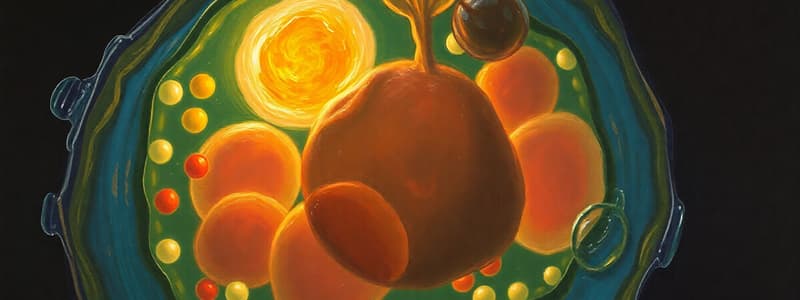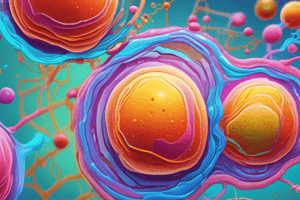Podcast
Questions and Answers
What is the primary function of the genetic material stored in DNA?
What is the primary function of the genetic material stored in DNA?
- To provide structural support to the plasma membrane
- To regulate the entry and exit of substances in the cell
- To serve as a source of energy for cellular functions
- To direct metabolic activities including growth and reproduction (correct)
Which best describes the arrangement of phospholipids in the plasma membrane?
Which best describes the arrangement of phospholipids in the plasma membrane?
- Triple layer of lipids with tails facing both inwards and outwards
- Single layer of lipids with hydrophilic heads facing inwards
- Double layer with hydrophilic heads facing outwards and hydrophobic tails facing inwards (correct)
- Double layer with hydrophobic tails facing outwards
What is the significance of proteins embedded within the plasma membrane?
What is the significance of proteins embedded within the plasma membrane?
- They provide mechanical strength to the cell
- They insulate the cell from its environment
- They store energy for cellular activities
- They facilitate the transfer of substances across the membrane (correct)
Which statement about the plasma membrane is true regarding its permeability?
Which statement about the plasma membrane is true regarding its permeability?
How do carbohydrate side chains contribute to the function of the plasma membrane?
How do carbohydrate side chains contribute to the function of the plasma membrane?
What role do lysosomes play in the degradation of cellular components?
What role do lysosomes play in the degradation of cellular components?
How are lysosomal enzymes kept from harming the cell?
How are lysosomal enzymes kept from harming the cell?
Which process describes the degradation of a cell's own components through lysosomal action?
Which process describes the degradation of a cell's own components through lysosomal action?
What is the main purpose of lysosomes releasing enzymes through exocytosis?
What is the main purpose of lysosomes releasing enzymes through exocytosis?
What is meant by autolysis in the context of lysosomal function?
What is meant by autolysis in the context of lysosomal function?
What is the primary function of lysosomes in a cell?
What is the primary function of lysosomes in a cell?
Which of the following describes the structure of the centrosome?
Which of the following describes the structure of the centrosome?
What role do microfilaments play in cellular processes?
What role do microfilaments play in cellular processes?
During which cell process does the centrosome play a critical role?
During which cell process does the centrosome play a critical role?
What is the relationship between myosin and microfilaments?
What is the relationship between myosin and microfilaments?
Which component of the lysosome is responsible for breaking down cellular waste?
Which component of the lysosome is responsible for breaking down cellular waste?
What is the diameter range of microfilaments?
What is the diameter range of microfilaments?
What cellular function is NOT associated with microtubules?
What cellular function is NOT associated with microtubules?
What happens to a cell that is damaged beyond repair, in relation to lysosomes?
What happens to a cell that is damaged beyond repair, in relation to lysosomes?
Which protein is primarily associated with the contraction of muscle tissue?
Which protein is primarily associated with the contraction of muscle tissue?
Flashcards are hidden until you start studying
Study Notes
Nucleus
- Stores genetic material (DNA)
- Directs all metabolic activities of the cell, including growth, metabolism, protein synthesis, and reproduction (cell division)
- Involved in cell division
- Instructs the synthesis of proteins/ribosomes & RNA
- Fundamental to cell survival
Plasma Membrane
- Controls the passage of substances in and out of the cell, regulating the intracellular environment
- Partially permeable
- Composed of two layers of lipids (mostly phospholipids)
- Phospholipids are hydrophilic ("water-loving") at their phosphate ends – facing outwards, and hydrophobic ("water-fearing") along their lipid tail regions – orientated inwards
- Embedded with proteins and carbohydrate molecules, which influence the transfer of substances that pass through the membrane
- Proteins passing all the way through the membrane allow for passage of electrolytes
Lysosomes
- A secretory vesicle formed by the Golgi apparatus
- Contain enzymes responsible for degrading proteins and membranes in the cell
- Aids degradation of materials ingested by the cell (due to hydrolytic (digestive) enzymes)
- Enzymes are kept apart from the cell to prevent them from destroying the cell's contents
- Kept inactive by an alkaline environment within the lysosome
- Abundant in cells with phagocytic activity, e.g. leukocytes
Lysosomes continued: Functions
- Autophagy: A process involving the degradation of a cell's own components through the lysosomal machinery
- Self Destruction: They release enzymes outside the cell (exocytosis) in order to break down other cells
- Autolysis: The destruction of a cell through the action of its own enzymes
Centrosome
- Directs the organization of microtubules within the cell
- Comprises a pair of centrioles (small clusters of microtubules)
- Plays an important part during cell division
Centrosome Function: Cell Division
- 2 centrioles, cylindrical structures, orientated at right angles to each other
- Act as organizers of the nuclear spindle during cell division
Microfilaments
- Composed predominantly of a contractile protein called actin, which is the most abundant cellular protein
- Fine, thread-like protein fibers, 3-6nm in diameter.
- Can carry out cellular movements, including gliding, contraction, and cytokinesis (the division of cytoplasm following division of a nucleus)
- Association with the protein myosin is responsible for muscle contraction
Microtubules
- Cylindrical tubes, 20-25nm in diameter, providing mechanical support and structure to the cell
- Involved in intracellular transport, e.g. the movement of chromosomes during cell division
- Important in the formation of flagella and cilia, which help move fluids and cells
Chromosomes
- Diploid = Complete set of chromosomes
- Gametes = Haploid (single set of chromosomes)
Meiosis
- A form of cell division which produces gametes
- Results in two genetically different daughter cells
- The homologous pairs swap some DNA
- Each daughter cell has 23 chromosomes only - haploid
Meiosis I
- The stages are similar to mitosis
- Homologous chromosomes pair up
- Homologous pairs divide and 2 daughter cells are produced
Meiosis II
- Genetic material in daughter cells is halved by a second division
- One chromosome from the original pair form a gamete
- 4 daughter haploid cells are produced
Cellular Transport
- The passage across cell plasma membranes is semi-permeable.
Transport of Substances Across Cell Membranes
- Passive transport: Diffusion and osmosis (no energy required)
- Active transport: Uses ATP (energy) to move substances against their concentration gradient.
- Bulk transport: Pinocytosis & Phagocytosis
Types of Cell Transport
- Diffusion: The process by which a substance moves from a region of high concentration to a region of low concentration
- Osmosis: The passage of water down its concentration gradient towards equilibrium across a semi-permeable membrane
- Active transport: Movement of a substance against its concentration gradient; requires ATP
- Phagocytosis: Cell engulfs large particles (e.g., bacteria)
- Pinocytosis: Cell engulfs fluids and dissolved substances
Lysosome Function: Apoptosis
- If a cell is damaged beyond repair, lysosomes help it to self-destruct by apoptosis (programmed cell death)
- Destroy invading viruses and bacteria
- Break down excess or worn-out cell parts
Studying That Suits You
Use AI to generate personalized quizzes and flashcards to suit your learning preferences.




